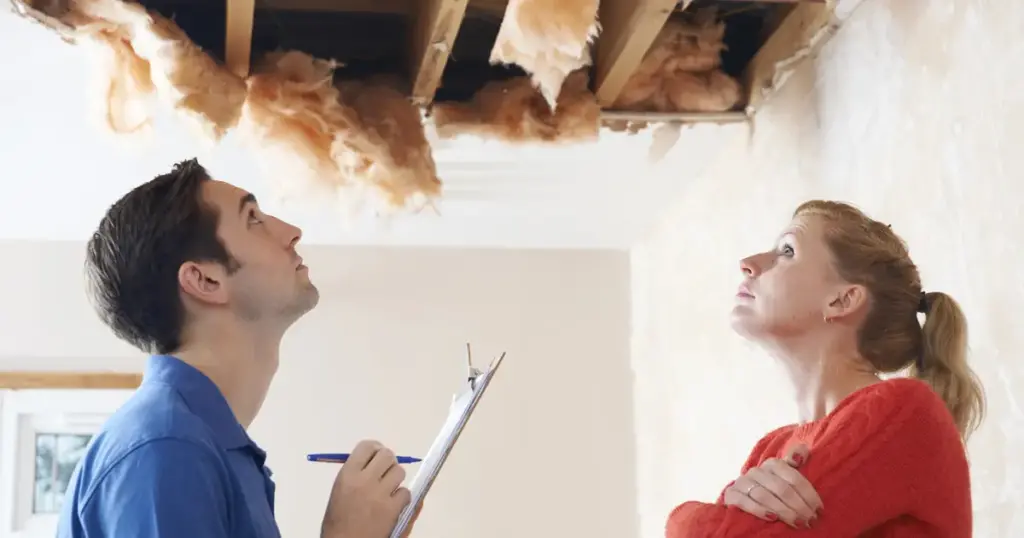When your roof sustains damage from strong winds, a storm, hail or other natural event, it’s important to understand how to navigate the insurance claims process as it can make a significant difference in the costs associated with repairing or replacing your roof. Navigating the insurance claims process for roof damage can be complex and overwhelming, but being informed and prepared can help reduce the stress and ensure you receive fair compensation for the repair or replacement of your roof.
What Every Homeowner Should Know About Insurance Claims for Roof Damage
1. Assess Any Roof Damage Immediately
When there is damage to your roof, be sure to inspect it as soon as possible, when it’s safe to do so. Look for missing or damaged shingles, leaks or debris. If you don’t feel comfortable with inspecting the roof yourself, hire a roofing contractor to complete a thorough inspection.
2. Understand Your Homeowner’s Insurance Policy
Before filing a claim for roof damage, review your homeowner’s insurance policy so you’re aware of the following:
- Coverage Limit: the maximum amount your insurance will pay for your roof damage
- Deductible: the amount you’ll need to pay before your insurance kicks in
- Covered Perils: damage from events such as wind, hail and fire are typically covered by insurance, however it may not cover roof damage from normal wear and tear, neglect and improper maintenance.
- Exclusions and Special Clauses: exclusions or specific conditions that may affect your claim.
3. Document Your Roof Damage Accurately
When filing an insurance claim for roof damage, it’s important to keep an accurate record of the details of your roof damage. Be sure to take clear photos and videos of all visible damage to your roof. This evidence will support your claim and serve as proof of the extent of your roof damage.
4. Hire a Qualified Roofing Contractor
A licensed and reputable roofing company will conduct a thorough inspection of your roof damage and provide you with a detailed assessment and repair estimate. Ensure that the roofing company has experience with insurance claims and is willing to work with your insurance adjuster as needed throughout the process.
5. Report Your Roof Damage and File Your Insurance Claim
Contact your insurance company to report your roof damage as soon as possible. Provide them with all your relevant documentation, including the inspection report from your roofing company, any photos or videos of the roof damage, and the estimate of your roof repair. In some cases, an insurance adjuster may visit your home to assess the roof damage.
6. Work with the Insurance Adjuster
Ensure you are present during the insurance adjuster’s inspection to answer questions and provide additional information. To help ensure a fair assessment, ask your roofing company to be present to discuss the scope of repairs and costs.
7. Understand the Settlement Offer
Once the insurance adjuster has completed your roof assessment, your insurance company will provide you with a settlement offer. Review this offer carefully to ensure it covers all necessary repairs. If you disagree with the settlement, you can negotiate or provide additional evidence to support your claim.
8. Complete Your Roof Repairs
Once you have finalized the settlement with your insurance company, work with the roofing company you’ve selected to complete the repairs. Ensure the work meets all local building codes and is completed to your satisfaction. Be sure to keep all receipts and documentation related to the roof repair.
9. Be Proactive to Prevent Future Damage to Your Roof
After your roof is repaired or replaced, take steps to prevent future roof damage. Regular maintenance, such as cleaning gutters, trimming overhanging branches, and scheduling regular roof inspections can help extend the lifespan of your roof and reduce the likelihood of future insurance claims.
Remember, your roof is a significant investment in your home’s protection, so taking the right steps after damage occurs is crucial. If you ever find yourself needing assistance, don’t hesitate to contact a professional roofing company to guide you through the process.

